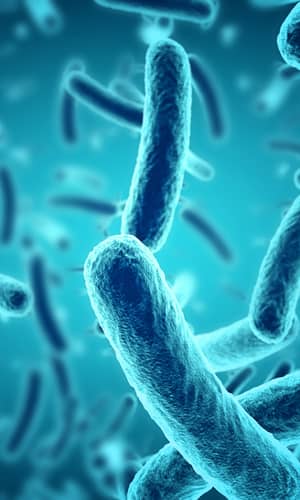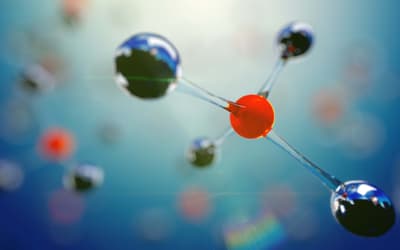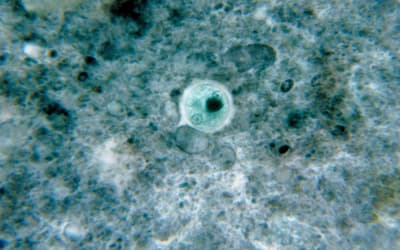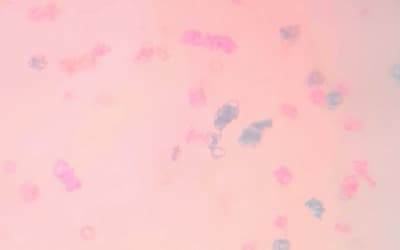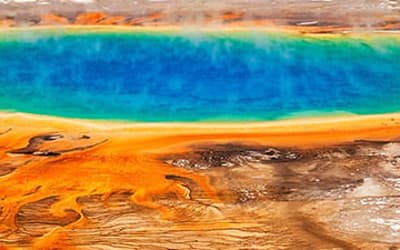The views expressed in this paper are those of the writer(s) and are not necessarily those of the ARJ Editor or Answers in Genesis.
Abstract
The world of germs and microbes has received much attention in recent years. But where do microbes fit into the creation account? Were they created along with the rest of the plants and animals in the first week of creation, or were they created later, after the Fall? These are some questions that creation microbiologists have been asking in recent years. Ongoing research, based on the creation paradigm, appears to provide some answers to these puzzling questions. The answers to these questions are not explicit in Scripture, so the answers cannot be dogmatic. However, a reasonable extrapolation from biological data and Scripture can be made about the nature of microbes in a fully mature creation. This article attempts to provide reasonable answers to when microbes were created and is meant to stimulate discussion and further research in this area. Very little has been written in Bible commentaries or in creation literature on the subject of when microbes were created. Some have postulated that microbes were created on a single day of Creation, such as Day Three—when the plants were made. This is partially due to the “seed-like” characteristics that bacteria and fungi have—therefore classifying microbes as plants. In addition, we observe microbes (such as Escherichia coli) isolated in the lab and we tend to think of microbes as individual entities much like birds or fish or animals and, therefore, created on a single day. However, in nature, the vast majority of microbes live in biological partnerships, not in total isolation. The natural symbiosis of microbes with other creatures is the norm. Therefore, we postulate that microbes were created as “biological systems” with plants, animals, and humans on multiple days, as supporting systems in mature plants, animals, and humans. This idea is further supported by the work of Francis (2003). Francis calls microbial symbiotic systems a biomatrix, or organosubstrate. He proposes that microbes were created as a link between macroorganisms and a chemically rich but inert physical environment, providing a surface (i.e., substrate) upon which multicellular creatures can thrive and persist in intricately designed ecosystems. From the beginning, God made His creation fully mature, and complex forms fully formed. This would ensure continuity and stability for the times to come. Although we cannot be certain as to specifically when the Creator made microbes, it is within His character to make entire interwoven, “packaged” systems to sustain and maintain life
Keywords: microbes, days of creation, symbiosis, biological partnerships, organosubstrate, packaged systems.

Escherichia coli
The world of germs and microbes has received much attention in recent years—and for good reason. We frequently hear the term microbe associated with organisms such as Escherichia coli, Salmonella, anthrax bacteria, antibiotic-resistant tuberculosis, MRSA, HIV, malaria, Stachybotrys, and other microscopic creatures. But where do microbes fit into the creation account? Were they created along with the rest of the plants and animals in the first week of creation, or were they created later, after the Fall? Are microbes a result of the Curse? These and other questions are some that a group of professional creation microbiologists have been asking, and their answers may surprise you. Ongoing research based on the creation paradigm appears to provide some answers to these puzzling questions. Although I cannot be dogmatic (beyond the biblical text) about the details of microbe origin during Creation Week, I believe that a reasonable extrapolation from biological data and Scripture can be made about the nature of microbes in a fully mature creation. Past creation scientists such as Leeuwenhoek, Pasteur, and Lister were blessed by God as He revealed (Psalm 139:17a) to them critical insight into His creation.
So, where do these microbes fit into the very good days of creation? Before answering this question, three terms, microbe, germ, and symbiosis, need to be defined. These are relatively new or “modern” terms. First, the Bible does not use these specific terms. These terms were not commonly used until the end of the nineteenth century. The term microbe was first used in 1878 to describe “extremely minute living beings.” Before 1878, scientists including Louis Pasteur used a variety of terms rather loosely to label the very small organisms that had interested them. It was not clear whether microbes belonged to the animal or plant kingdom, or to a completely different one. The term microbe was given by Charles E. Sedillot to describe bacteria (Bulloch 1938). Later, it would also be used of eukaryotic cells, including algae, fungi, protozoans, and slime molds. Some people refer to viruses as microbes, but others do not because viruses are not cells. Viruses have nonliving as well as living characteristics.
Today, the term germ refers to disease-causing microbes, or pathogens. All germs would have originated after the Fall (Genesis 3). The Edenic Curse would have profoundly influenced all creation, including viruses, bacteria, fungi, and protozoans that would later become pathogens or parasites. The origin of infectious disease is complex and multifaceted. This topic is further explored in the book The Genesis of Germs (Gillen 2007). It provides some understanding into the origin of infectious diseases. From a biblical worldview, infectious diseases and pathogenesis are a secondary state in nature. It is not the way the Creator intended for man and nature.
Most microbes are beneficial to man and nature. Only about 5–10% of all bacteria are pathogenic. Many microbes live in a mutualistic relationship with plants, animals, humans, and other microbes. Mutualism is a type of symbiosis (Greek sym, meaning “together”, and bios, meaning “life”). The term symbiosis is used to describe an intimate association between organisms of different species. Some symbiotic relationships between microbes and plants, animals, and humans are essential for life on earth. For this reason most microbiologists maintain that bacteria, fungi, protists, and other microbes have been maligned in the news media. Without our intestinal flora, we would not digest food nor acquire vitamins and minerals very efficiently. Without fungi, bacteria, algae, and protozoans, life on earth could not last. This is because microbes provide essential “services” (e.g., nitrogen fixation, nitrification, and denitrification) in nutrient cycles.
The Days of Creation
On each day of creation, God wrought a plethora of wonders, and each day’s work perfectly complemented the other (MacArthur 2001). God created the earth with its untold living marvels out of nothing. Three days out of six, He made living (biologically speaking) things. You may recall the creation of life in three distinct days from the Genesis account (table 1).
| Creation Week | Life-forms |
|---|---|
| Day Three | Plants and seed-bearing life |
| Day Five | Sea animals and flying animals |
| Day Six | Creeping things, land animals, and humans |
I once believed that all microbes were simply created on Day Three—with all the plants (and seed-bearing life). The Bible says,
And God said, Let the earth bring forth grass, the herb yielding seed, and the fruit tree yielding fruit after his kind, whose seed is in itself, upon the earth: and it was so. And the earth brought forth grass, and herb yielding seed after his kind, and the tree yielding fruit, whose seed was in itself, after his kind: and God saw that it was good (Genesis 1:11–12).
Some Bible commentaries have implied their creation on this day because bacteria and fungi were long classified in the plant kingdom.
Upon further reflection on the origin of microbes, I realized that not all microbes could be classified as “seed-bearing” life, like plants, cyanobacteria, or photosynthetic bacteria. This led me to the conclusion that the Creator probably created animal-like (nonphotosynthetic) microbes on Days Five and Six. In this model, God created individual microbes in discrete packages on several days (i.e., the plant-like microbes on Day Three, the animal-like microbes with the animals, etc., on Days Five and Six). Each bacteria, fungi, and protozoan “kind” was made individually on Days Three, Five, and Six, just like plants, animals, and humans.
In June 2007, a group of professional creation microbiologists assembled at the Answers in Genesis Creation Museum to meet and discuss ideas and papers at the first Microbe Forum (Purdom and Francis 2008). After several sessions presented by scientists, I further appreciated the natural symbiosis of microbes and other creatures, because it occurred to me that seldom are microbes living in total isolation. Upon further reflection, I concluded that it is much more likely that God created the microbes as “biological systems” on multiple days of creation (table 2). It is less likely that a single day in creation would explain the vast diversity of microbes (i.e., viruses, bacteria, fungi, algae, protozoans, etc.)—although He certainly could have. In fact, this “new conception” of when microbes were created is a change in my thinking that has taken place over the past few years. My “new” understanding of microbes and the days of creation is further explained below.
| Creation Week | Symbioitic Association of Microbe and Life-forms |
|---|---|
| Day Three | Peanut plants with Rhizobium (nitrogen-fixing bacteria); arborvitae tree with mycorrhizal fungi |
| Day Five | Coral with zooxanthellae (algae); squid with Vibrio fishcheri (bacteria); Flashlight fish with Photobacterium; parrot caeca with cellulosedigesting bacteria |
| Day Six | Termites with Trichonympha (protozoans); cattle rumen with methanogenic bacteria; human intestines with E. coli (bacteria); human reproductive system with ERVs |
Francis (2003) calls microbial symbiotic systems a biomatrix, or organosubstrate. Francis proposes that microbes and viruses were created as a link between macroorganisms and a chemically rich, but inert, physical environment, providing a surface (i.e., substrate) upon which multicellular creatures can thrive and persist in intricately designed ecosystems. Microbes are designed for symbiotic relationships with both macroorganisms and other microbes and viruses. They extract inorganic minerals from the earth; participate in the cycling of all elements and compounds important in macroorganismal biology; and effect bioremediation. Microbes and man, plants and fungi, invertebrates and protozoans are intricately connected with one another—all designed by the Master Weaver (Gillen 2007).
At God’s command, He made trees, flowers, shrubs, and grasses on Day Three. The Master Craftsman wove diverse life-forms together. When God created the plants (Day Three), He likely created a biomatrix of bacteria and fungi with them at the same time to sustain them (table 2). This symbiotic model for the origin of microbes does not preclude free-living forms. The natural ecosystems that God created—land, sea, and air—would also need microbes for nutrient cycling, decomposing waste, and photosynthesis for oxygen for all creatures. The soil surrounding the plants most likely accommodated the need to recycle elements from fallen leaves and make them useful for regeneration.
By Day Five of creation, earth’s environment and the heavenly realm were complete. From here on the creative work of God consisted primarily in filling the earth with “moving” creatures. On this breath-taking day (Day Five) the Master Creator made sea animals, including coral, squid, fish, and whales. He also created the birds, bats, and other winged creatures. God populated the seas and skies with animals that would need the ability to acquire nutrients, utilize energy efficiently, and reproduce. In His provision, God made microscopic creatures that could live in mutualism with “everything” that moves. The Sustainer of all life created symbiotic microbes like bacteria, fungi, algae, and protozoans to uphold and maintain these marvelous ocean and atmospheric creatures (table 2). They would also have to communicate with one another. For example, in the deep oceans, squid and flashlight fish have luminescent symbiotic bacteria living inside their bodies to light their way and communicate with other creatures. Living corals have dinoflagellate algae living inside them to provide food (from photosynthesis), and the coral body, in turn, provides a stable home for the algae, as ocean currents sway the small animals on the atoll (an oceanic, reef formation by corals). Birds digest (cellulose) food better with bacteria living inside their caecum stomach.
When He created the “creeping things” like termites on Day Six, He created the protozoans and bacteria interwoven in their gut to ensure their survival. Very few animals can digest wood and hard cellulose. Termites have mutualistic, flagellated protozoans called Trichonympha (even the Trichonympha have symbiotic bacteria inside them) living inside their guts. We see this pattern of mutualistic bacteria living inside larger animals as well. When He created cattle (ruminants), He created the methanogenic bacteria inside their rumen to digest food. Finally, in His most brilliant stroke, He wove together man with microbes (table 2). Most land animals have billions of symbiotic bacteria or fungi living inside them to uphold their life. Just like an embroidered quilt, He made humans with bacteria on their skin and in their intestines. When He created man, He also created E. coli in their intestines to help them digest food, etc. Located on his skin, Staphylococcus epidermidis helps protect his skin. Man is “covered” inside and outside his body with millions of microbiotic organisms (i.e., normal flora) to maintain normal body functions and sustain life in changing environments.
Where Do Viruses Fit into Creation?
The determination of virus origin is uncertain. It may be that viruses (as we classify them today) have multiple origins. Some may be degenerate parts from cells after the Curse; still others may have their origin during the days of creation. Today, we think of viruses (Latin for “poison”) only in the context of disease. However, some viruses (or at least virus-like genes) are involved in a positive function in nature. Some groups of viruses, like bacteriophages, play a positive role in controlling bacteria in ecosystems and may play a role in diversity. Another group of viruses play a role in turning off the immune system during pregnancy in mammals and humans (Liu 2007). This is a group referred to as endogenous retroviruses (ERVs). ERVs are among a kind of repetitious genetic elements called “retrotransposons”.
Research has shown that the ERV design prohibits the mother’s immune system from damaging the child’s body. These retroviruses cannot fully replicate, only expressed in local immune cells (such as macrophages) of the placenta, thereby preventing them from initiating a full-blown immune response (Gillen and Sherwin 2005; Liu 2007). Thus, the mother’s immune system remains competent to respond to other infections but is specifically prevented from mounting an immune response to the developing embryo (Gillen and Sherwin 2005; Liu 2007). So in creation, the selective ability to turn off the immune system for protection would be a “good” design. Other ERVs also play a positive role in animal and human reproduction. However, since the corruption of creation, the corrupted retrovirus, HIV, and various leukemia viruses turn off the entire immune system, leaving the body open to devastating infections. These examples may provide clues to the origin of viruses and how some may have been created during Creation Week by design and how some have been corrupted as a result of the Fall.
The Master Craftsman
The Almighty did some of His most awesome work in the first six days of the planet’s existence. Although He created the starry host with galaxies, planets, moons, the sun, and other large objects, He also created microorganisms demonstrating His care for detail in the minutest part of life. God built into all living things the need to sustain, repair, and reproduce. In many cases, microbes are essential for these three processes to take place in plants, animals, and humans. From the beginning, God made His creation fully mature and complex forms fully formed. This would ensure continuity and stability for the times to come. Although we cannot be certain as to how and specifically when the Creator made viruses and microbes, it is within His character to make entire “packaged” systems to sustain and maintain life. If you think about God as an artist who paints an oil canvas, He does it with entire strokes: He does not paint by numbers.
Notes
The genesis of germs comes after the Creation and the Curse. Pathogens (i.e., germs) cannot be explained from the Creation account of Genesis 1 and 2. The origin of infectious disease does not come until after the Curse recorded in Genesis 3. You can read more about this topic in the book The Genesis of Germs (Gillen 2007).
References
Atlas, R. M., and R. Bartha. 1998. Microbial ecology: Fundamentals and applications, 4th ed. San Francisco, California: Benjamin Cummings.
Bulloch, W. 1938. The history of bacteriology. New York: Dover Publications.
Francis, J. W. 2003. The organosubstrate of life: A creationist perspective of microbes and viruses. In Proceedings of the Fifth International Conference on Creationism, ed. R. L. Ivey, Jr., pp. 434–444. Pittsburgh, Pennsylvania: Creation Science Fellowship.
Gillen, A. L. 2007. The genesis of germs: Disease and the coming plagues in a fallen world. Green Forest, Arkansas: Master Books.
Gillen, A. L. and F. Sherwin. 2005. The immune system: Designed to interact with microbes. Origins (A Journal of the Biblical Creation Society) 40:5–9.
Lim, D. V. 2003. Microbiology, 3rd ed. Dubuque, Iowa: Kendall/Hunt.
Liu, Y. 2007. Endogenous retroviruses: Remnants of germline infection or created in the cell? In All creation groans: The problem of natural evil, Proceedings of the Sixth BSG Conference, ed. R. W. Sanders, Occasional Papers of the BSG 10:19–20.
MacArthur, J. 2001. Battle for the Beginning. Nashville, Tennessee: Thomas Nelson.
Morris, H. M. 2006. The New Defender’s Study Bible (KJV). Grand Rapids, Michigan: Word Publishing.
Purdom, G., and J. W. Francis, eds. 2008. Proceedings of the Microbe Forum, June 2007. Answers Research Journal 1:1–6.
